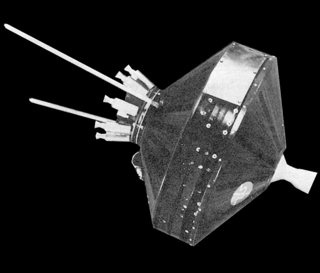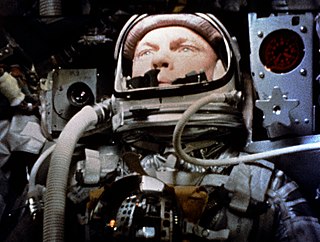
Project Mercury was the first human spaceflight program of the United States, running from 1958 through 1963. An early highlight of the Space Race, its goal was to put a man into Earth orbit and return him safely, ideally before the Soviet Union. Taken over from the US Air Force by the newly created civilian space agency NASA, it conducted 20 uncrewed developmental flights, and six successful flights by astronauts. The program, which took its name from Roman mythology, cost $2.68 billion. The astronauts were collectively known as the "Mercury Seven", and each spacecraft was given a name ending with a "7" by its pilot.

Atmospheric entry is the movement of an object from outer space into and through the gases of an atmosphere of a planet, dwarf planet, or natural satellite. There are two main types of atmospheric entry: uncontrolled entry, such as the entry of astronomical objects, space debris, or bolides; and controlled entry of a spacecraft capable of being navigated or following a predetermined course. Technologies and procedures allowing the controlled atmospheric entry, descent, and landing of spacecraft are collectively termed as EDL.

The Ames Research Center (ARC), also known as NASA Ames, is a major NASA research center at Moffett Federal Airfield in California's Silicon Valley. It was founded in 1939 as the second National Advisory Committee for Aeronautics (NACA) laboratory. That agency was dissolved and its assets and personnel transferred to the newly created National Aeronautics and Space Administration (NASA) on October 1, 1958. NASA Ames is named in honor of Joseph Sweetman Ames, a physicist and one of the founding members of NACA. At last estimate NASA Ames had over US$3 billion in capital equipment, 2,300 research personnel and a US$860 million annual budget.

Spaceflight is an application of astronautics to fly objects, usually spacecraft, into or through outer space, either with or without humans on board. Most spaceflight is uncrewed and conducted mainly with spacecraft such as satellites in orbit around Earth, but also includes space probes for flights beyond Earth orbit. Such spaceflight operate either by telerobotic or autonomous control. The more complex human spaceflight has been pursued soon after the first orbital satellites and has reached the Moon and permanent human presence in space around Earth, particularly with the use of space stations. Human spaceflight programs include the Soyuz, Shenzhou, the past Apollo Moon landing and the Space Shuttle programs. Other current spaceflight are conducted to the International Space Station and to China's Tiangong Space Station.

Pioneer 2 was the last of the three project Able space probes designed to probe lunar and cislunar space. The launch took place at 07:30:21 GMT on 8 November 1958. After Pioneer 1 had failed due to guidance system deficiencies, the guidance system was modified with a Doppler command system to ensure more accurate commands and minimize trajectory errors. Once again, the first and second stage portion of the flight was uneventful, but the third stage of the launch vehicle failed to ignite, making it impossible for Pioneer 2 to achieve orbital velocity. An attempt to fire the vernier engines on the probe was unsuccessful and the spacecraft attained a maximum altitude of 1,550 km (960 mi) before reentering Earth's atmosphere at 28.7° N, 1.9° E over NW Africa. A small amount of data was obtained during the short flight, including evidence that the equatorial region around Earth has higher flux and higher energy radiation than previously considered and that the micrometeorite density is higher around Earth than in space. The reason for the third stage failure was unclear, but it was suspected that the firing command from the second stage, which contained the guidance package for the entire launch vehicle, was never received, possibly due to damage to electrical lines during staging.

Pioneer 1 was an American space probe, the first under the auspices of NASA, which was launched by a Thor-Able rocket on 11 October 1958. It was intended to orbit the Moon and make scientific measurements, but due to a guidance error failed to achieve lunar orbit and was ultimately destroyed upon reentering Earth's atmosphere. The flight, which lasted 43 hours and reached an apogee of 113,800 km, was the second and most successful of the three Thor-Able space probes.

Mercury-Atlas 6 (MA-6) was the first crewed American orbital spaceflight, which took place on February 20, 1962. Piloted by astronaut John Glenn and operated by NASA as part of Project Mercury, it was the fifth human spaceflight, preceded by Soviet orbital flights Vostok 1 and 2 and American sub-orbital flights Mercury-Redstone 3 and 4.

Mercury-Atlas 7, launched May 24, 1962, was the fourth crewed flight of Project Mercury. The spacecraft, named Aurora 7, was piloted by astronaut Scott Carpenter. He was the sixth human to fly in space. The mission used Mercury spacecraft No. 18 and Atlas launch vehicle No. 107-D.

Gemini 1 was the first mission in NASA's Gemini program. An uncrewed test flight of the Gemini spacecraft, its main objectives were to test the structural integrity of the new spacecraft and modified Titan II launch vehicle. It was also the first test of the new tracking and communication systems for the Gemini program and provided training for the ground support crews for the first crewed missions.

Saturn-Apollo 3 (SA-3) was the third flight of the Saturn I launch vehicle, the second flight of Project Highwater, and part of the American Apollo program. The rocket was launched on November 16, 1962, from Cape Canaveral, Florida.

A spaceplane is a vehicle that can fly and glide like an aircraft in Earth's atmosphere and maneuver like a spacecraft in outer space. To do so, spaceplanes must incorporate features of both aircraft and spacecraft. Orbital spaceplanes tend to be more similar to conventional spacecraft, while sub-orbital spaceplanes tend to be more similar to fixed-wing aircraft. All spaceplanes to date have been rocket-powered for takeoff and climb, but have then landed as unpowered gliders.

Big Joe 1 (Atlas-10D) launched an uncrewed boilerplate Mercury capsule from Cape Canaveral, Florida on 9 September 1959. The purposes of the Big Joe 1 were to test the Mercury spacecraft ablative heat shield, afterbody heating, reentry dynamics attitude control and recovery capability. It was also the first launch of a spacecraft in Project Mercury.

Mercury-Atlas 2 (MA-2) was an uncrewed test flight of the Mercury program using the Atlas rocket. It launched on February 21, 1961, at 14:10 UTC, from Launch Complex 14 at Cape Canaveral, Florida, United States.

A space capsule is a spacecraft designed to transport cargo, scientific experiments, and/or astronauts to and from space. Capsules are distinguished from other spacecraft by the ability to survive reentry and return a payload to the Earth's surface from orbit or sub-orbit, and are distinguished from other types of recoverable spacecraft by their blunt shape, not having wings and often containing little fuel other than what is necessary for a safe return. Capsule-based crewed spacecraft such as Soyuz or Orion are often supported by a service or adapter module, and sometimes augmented with an extra module for extended space operations. Capsules make up the majority of crewed spacecraft designs, although one crewed spaceplane, the Space Shuttle, has flown in orbit.

The Scout family of rockets were American launch vehicles designed to place small satellites into orbit around the Earth. The Scout multistage rocket was the first orbital launch vehicle to be entirely composed of solid fuel stages. It was also the only vehicle of that type until the successful launch of the Japanese Lambda 4S in 1970.

The Minotaur is a family of United States solid fuel launch vehicles derived from converted Minuteman and Peacekeeper intercontinental ballistic missiles (ICBM). They are built by Northrop Grumman via contract with the Air Force Space and Missile Systems Center's Space Development and Test Directorate (SMC/SD) as part of the Air Force's Rocket Systems Launch Program which converts retired Intercontinental Ballistic Missiles into space and test launch systems for U.S. government agencies.

Antares, known during early development as Taurus II, is an expendable launch system developed by Orbital Sciences Corporation and the Pivdenne Design Bureau to launch the Cygnus spacecraft to the International Space Station as part of NASA's COTS and CRS programs. Able to launch payloads heavier than 8,000 kg (18,000 lb) into low Earth orbit, Antares is the largest rocket operated by Northrop Grumman. Antares launches from the Mid-Atlantic Regional Spaceport and made its inaugural flight on April 21, 2013. Antares 100 was retired in 2014 and series 200 was retired in 2023 due to component unavailability. As of January 2024 Antares 300 is under development.

Non-ballistic atmospheric entry is a class of atmospheric entry trajectories that follow a non-ballistic trajectory by employing aerodynamic lift in the high upper atmosphere. It includes trajectories such as skip and glide.

OA-6, previously known as Orbital-6, is the sixth flight of the Orbital ATK uncrewed resupply spacecraft Cygnus and its fifth flight to the International Space Station under the Commercial Resupply Services (CRS) contract with NASA. The mission launched on 23 March 2016 at 03:05:52 UTC.

OA-7, previously known as Orbital-7, is the eighth flight of the Orbital ATK uncrewed resupply spacecraft Cygnus and its seventh flight to the International Space Station (ISS) under the Commercial Resupply Services contract with NASA. The mission launched on 18 April 2017 at 15:11:26 UTC. Orbital and NASA jointly developed a new space transportation system to provide commercial cargo resupply services to the International Space Station (ISS). Under the Commercial Orbital Transportation Services (COTS) program, then Orbital Sciences designed and built Antares, a medium-class launch vehicle; Cygnus, an advanced maneuvering spacecraft, and a Pressurized Cargo Module which is provided by Orbital's industrial partner Thales Alenia Space.































